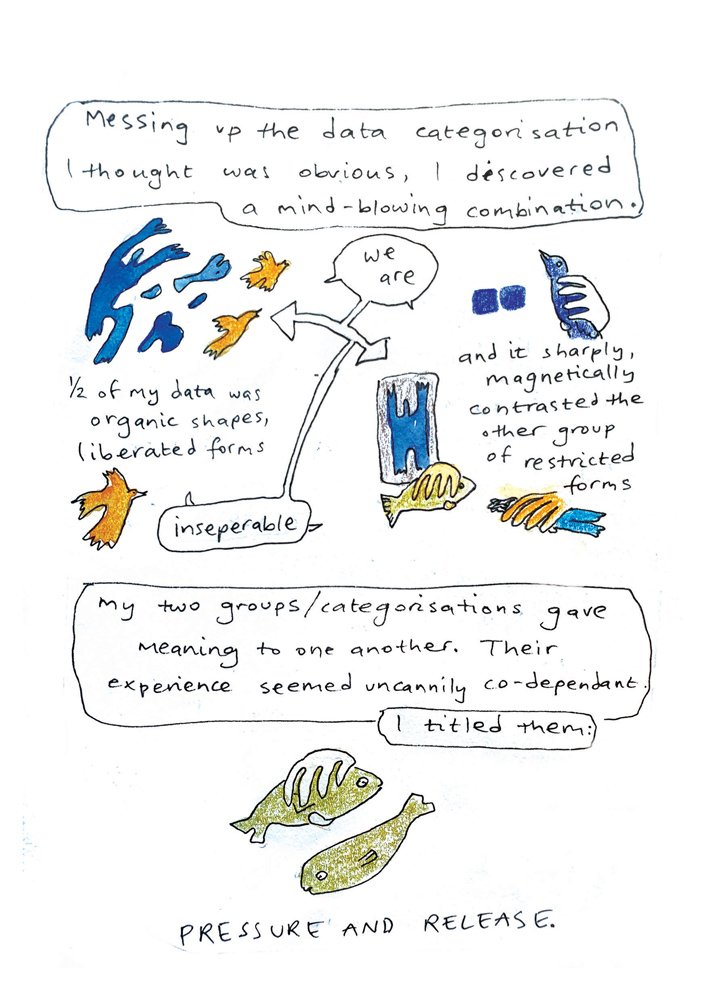Published:
August 2022
Issue:
Vol.17, No.1
Word count:
461
About the author
-
PostGradDipAT, BA
Sofia is an artist and community-engaged arts coordinator living on unceded Wurundjeri Country. She uses arts-based research, story-telling, sensory ecology and murals to celebrate the local ecology, and explore her role in the environment, as a settler Australian during a time of climate crisis. Her work is informed by her Palestinian and Irish heritage, and the need for land/earth rights via stories which generate hope, belonging and resistance. She has been working as an arts facilitator and eco-literacy educator for people of all ages and sensory profiles for five years.
This work is published in JoCAT and is licensed under a CC BY-NC-ND-4.0 license.
ABR-ah-To-d-ABR-ah: A comic processing my arts-based research into arts-based research
Sofia Sabbagh
Creative art therapist statement
Making this comic helped me to process my studies at MIECAT in the experiential study of arts-based research (ABR).
I started writing comics instead of essays while studying for a Bachelor of Indigenous Studies at the University of Melbourne. I found it counterintuitive to be discussing decolonisation while using colonial frameworks of reasoning. Comics, on the contrary, communicate with the reader’s senses. Comics can be a source of knowledge as well as a ‘mode of knowledge’, due to their sensory engagement with the maker and the reader (Barrett & Bolt, 2007, p.2). In the academic realm, using stories and visual stimuli to portray meaning – implicit and explicit – emphasises the spaces ignored by colonial knowledge frameworks, and thus illustrates the limitations of such reasoning.
Creating the comic surprised me, as it furthered my research into ABR. The visual format mirrored my experience back to me, and thus I could witness my story. Some drawings took two goes to get right, but when they were right I felt like I had linked my feelings with my page. The images still ring eerily in my body, as though reminding me of things experienced and unspoken. The use of documentation and narrative to gain perspective and strength from my lived experience mirrors techniques used in narrative therapy to empower people in the authorship of their own lives (Epston & White, 1992). Having written the comic, I find that the knowledge learnt is more readily at my disposal, as if the narrative format has inscribed the tools into my bodily memory. Publicising the comic simultaneously deepens and detaches my identification with the narrative. I shy away from narrative identification, knowing that each person will have a unique interpretation of the story that is no longer my own experience. I am also more empowered by the narrative, knowing that it is publicly accepted.
As a research practice, ABR has become, for me, a paradigm distinguished from quantitative or qualitative research (Leavy, 2009). The transdisciplinary (McNiff, 2018) and reflexive approach has the potential to disrupt and disturb qualitative research (Leavy, 2009) as well as social structures. While ABR can be used to socially inform quantitative research (Finley, 2005), its point of difference is in its active valuing of experience and the coexistence of multiple truths. The visual format of my comic reflects ABR values of multiple truths. Illustrating my subjective learning process by using cartoon characters allows the reader and me to both empathise with, and separate ourselves from, the experience. The subjectivity of the experience is implicit in the cartoon, acknowledging multiplicity and diversity. Many arts-based researchers have recognised that the qualitative/quantitative emphasis on empirical truths can deny the truths experienced with our bodies and our environments (Conquergood, 2002; Leavy, 2009; Sousanis, 2015).
References
Barone, T., & Eisner, E.W. (2021). What are some criteria for assessing arts based research? Arts based research (pp.145–155). Sage.
Barrett, E., & Bolt, B. (Eds). (2007). Practice as research: Approaches to creative arts enquiry. I.B. Tauris & Co.
Boal, A. (1998). Legislative theater: Using performance to make politics. Routledge.
Bush, S. (2013). Being with/in the spare of us: An emergent arts inquiry [Doctoral Dissertation, MIECAT], 1, 1–39.
Conquergood, D. (2002). Performance Studies: Interventions and radical research. TDR/The Drama Review, 46(2), 145–156.
Epson, D., & White, M. (1992). Experience, contradiction, narrative and imagination: Selected papers of David Epson & Michael White, 1989–1991. Dulwich Centre Publications.
Finley, S. (2005). Arts-based inquiry: Performing revolutionary pedagogy. In N.K. Denzin & Y.S. Lincoln (Eds.), The Sage handbook of qualitative research (3rd ed., pp.681–694). Sage Publications.
Levy, P. (2009). Method meets art: Arts-based research practice. Guilford Press.
McNiff, S. (2018). Using art as research in learning and teaching. Multidisciplinary approaches across the arts. Intellect Books Ltd.
McNiff, S (2014). Art speaking for itself: Evidence that inspires and convinces. Journal of Applied Arts and Health, 5(2), 256–258.
Sajnani, N. (2012). Improvisation and arts-based research. Journal of Applied Arts and Health, 3(1), 79–86.
Savin-Baden, M. & Fisher, A. (2002) Modern fieldwork, Part 1: Realizing the potential. British Journal of Occupational Therapy, 65(6), 275–282.
Sousanis, N. (2015). Unflattening. Harvard University Press.


























